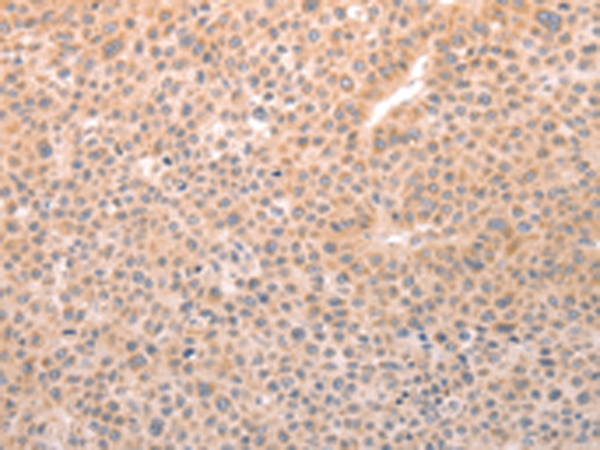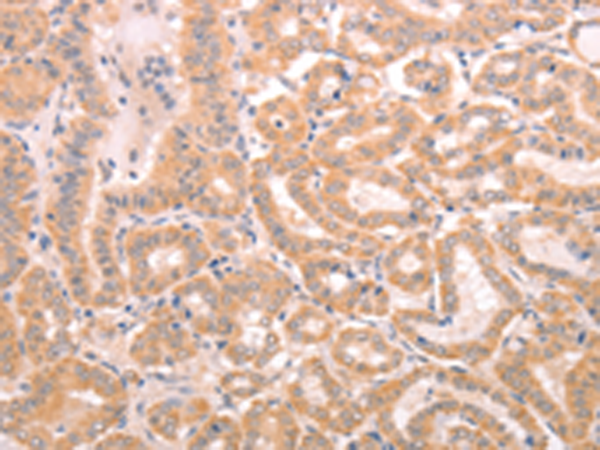

| WB | 咨询技术 | Human,Mouse,Rat |
| IF | 咨询技术 | Human,Mouse,Rat |
| IHC | 1/50-1/200 | Human,Mouse,Rat |
| ICC | 技术咨询 | Human,Mouse,Rat |
| FCM | 咨询技术 | Human,Mouse,Rat |
| Elisa | 1/2000-1/10000 | Human,Mouse,Rat |
| Aliases | TRP3 |
| Host/Isotype | Rabbit IgG |
| Antibody Type | Primary antibody |
| Storage | Store at 4°C short term. Aliquot and store at -20°C long term. Avoid freeze/thaw cycles. |
| Species Reactivity | Human, Mouse, Rat |
| Immunogen | Synthetic peptide of human TRPC3 |
| Formulation | Purified antibody in PBS with 0.05% sodium azide and 50% glycerol. |
+ +
以下是关于TRPC3抗体的3篇参考文献,包含文献名称、作者及摘要概括:
---
1. **文献名称**:*TRPC3 Mediates Neuronal Survival in Alzheimer’s Disease by Regulating Calcium Homeostasis*
**作者**:S. Wu et al. (2018)
**摘要**:该研究利用TRPC3特异性抗体,发现TRPC3通道在阿尔茨海默病(AD)模型中通过调节钙稳态保护神经元免受β-淀粉样蛋白毒性,抗体阻断TRPC3加剧神经元凋亡,提示其作为潜在治疗靶点。
2. **文献名称**:*Selective Inhibition of TRPC3 Channels by a Monoclonal Antibody Attenuates Vascular Remodeling in Hypertension*
**作者**:J. Lin et al. (2020)
**摘要**:研究开发了一种靶向TRPC3的单克隆抗体,证明其通过抑制TRPC3介导的钙内流,有效减轻高血压模型中的血管平滑肌增生和血管重构,为心血管疾病治疗提供新策略。
3. **文献名称**:*TRPC3 Antibody Validation in Cardiac Myocytes: Implications for Hypertrophic Signaling*
**作者**:B. Harbeck et al. (2016)
**摘要**:该文献系统验证了TRPC3抗体在心肌细胞中的特异性,并揭示TRPC3通过激活钙调神经磷酸酶信号通路促进心肌肥大,抗体阻断可抑制病理性心脏肥大进展。
---
以上文献聚焦于TRPC3抗体在疾病机制研究中的关键作用,涵盖神经保护、血管重塑及心脏病理等领域。如需具体文献来源,建议通过PubMed或期刊数据库进一步检索。
TRPC3 (Transient Receptor Potential Canonical 3) is a member of the TRP family of cation channels, which play critical roles in cellular calcium (Ca²⁺) signaling. It functions as a non-selective cation channel permeable to Ca²⁺ and Na⁺, and is activated by phospholipase C (PLC)-coupled receptors, contributing to diverse physiological processes such as neuronal excitability, cardiovascular regulation, and cell proliferation. TRPC3 is widely expressed in tissues, including the brain, heart, and immune cells, and its dysregulation has been implicated in neurodegenerative diseases, hypertension, and cancer. Research on TRPC3 often focuses on its structural dynamics, regulatory mechanisms (e.g., interactions with proteins like calmodulin or STIM1), and its role in disease pathways.
TRPC3 antibodies are essential tools for studying the expression, localization, and function of this channel. They are commonly used in techniques like Western blotting, immunohistochemistry, and immunofluorescence to detect TRPC3 protein levels in cell lysates or tissue sections. High-quality antibodies are validated for specificity, often through knockout controls, to minimize cross-reactivity with other TRP isoforms (e.g., TRPC6 or TRPC7). Recent studies also employ TRPC3 antibodies in co-immunoprecipitation assays to investigate protein-protein interactions or post-translational modifications. As TRPC3 gains attention as a therapeutic target, these antibodies support drug discovery efforts by enabling the assessment of channel modulation in disease models. Researchers prioritize antibodies with well-documented batch consistency and application-specific validation to ensure reproducibility in experimental outcomes.
×